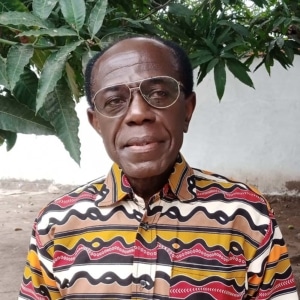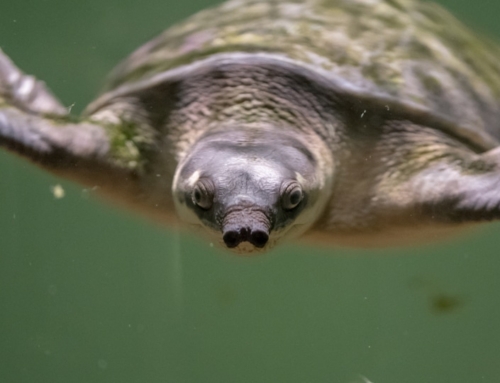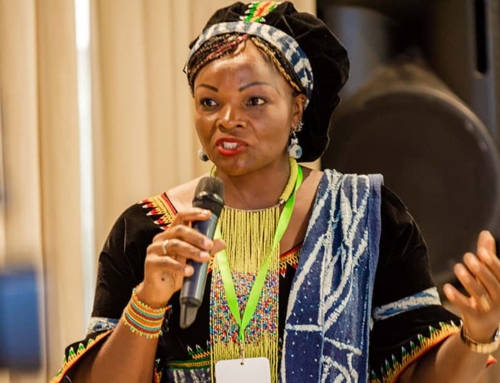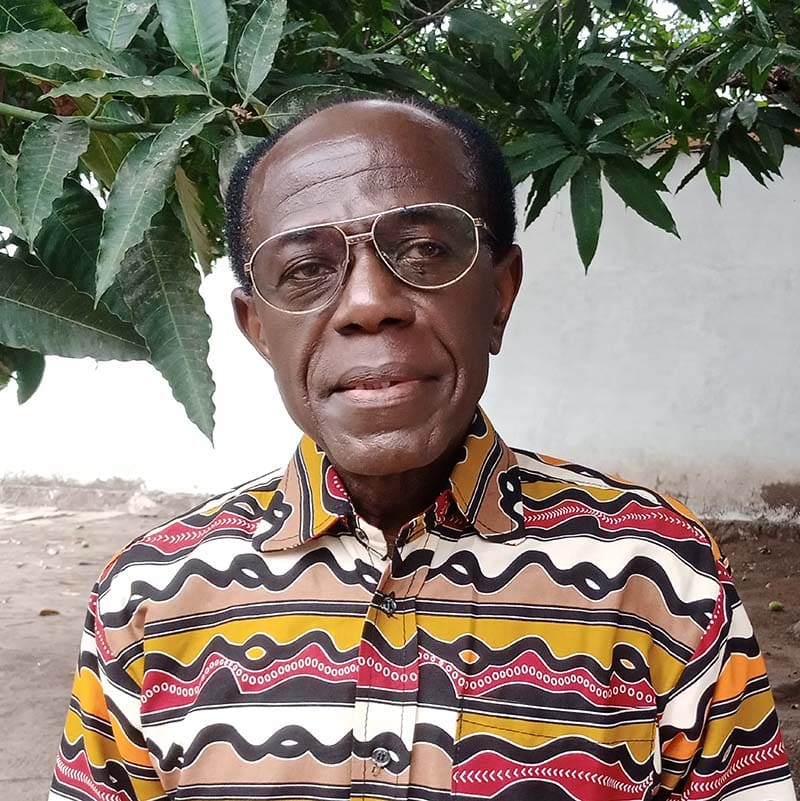
In conversation with Nina Seale, he discusses his long career, his concerns, and the highlights from working with Synchronicity Earth’s Congo Basin Programme partners as one of our Congo Basin affiliates.
A forest identity
According to your biography, you first trained as a vet before studying applied environment and biology. What made you move from medicine to wildlife?
Bihini: I think it’s connected to the origin of my name. My name is Musiti, which means forest. I was also born in a remote area, where the culture of the communities was close to gathering, fishing, and hunting rather than raising large livestock. So, the forest has always been my concern. After my studies, I was initially recruited to work for a poultry company, but when the funding was no longer available, I was looking for another job and the Institut Congolais pour la Conservation de la Nature (ICCN) was looking for research assistants. At first, I was just looking for a job, I wasn’t attracted to the idea of working on protected areas, but then the longer I worked there, the more I was attracted to the natural world. Then I realised that my name was connected to the nature, and that by doing my job I was protecting my name.
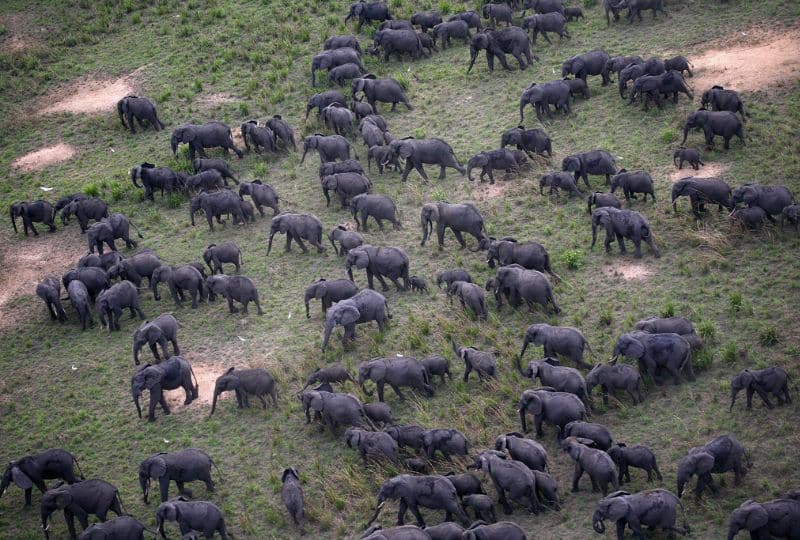
Bihini’s conservation career began with working in the Democratic Republic of Congo’s national parks, such as Garamba National Park. Image: Nuria Ortega/African Parks Network CC BY-NC-ND 2.0 DEED
Reconnecting conservation with community
So, your career really began with developing your passion for forests, but most of your career has been about working with people and communities. When do you think you realised how important it was to work with people to protect forests?
Bihini: At first, I was working with the rangers who were doing anti-poaching patrols and counting animals. But in the beginning working with rangers was not giving me an opportunity to connect with people because, at that time, at the level of state institutions, there was not yet a participatory resource management approach and conservation was not envisaged for people. It was about keeping the protected areas separate from people by telling them not to come in and that they couldn’t do what they wanted there.
But I began to understand that the centre of conservation was people when many conflict resolution processes started in the national parks. People were being arrested for poaching and claiming their land, because their land had been used for the national park. After that, I understood that people were central for what we were trying to do.
Land management should not only serve nature, but it should also enable communities to use their land sustainably. From that moment on, we decided to take a people-centred approach, to listen to their requests and to find out how not to put them aside, but to take their needs and the needs of the protected area into consideration. You cannot separate the two.
If there was already bad feeling between the communities and the rangers, how hard was it to try to recover those relationships?
Bihini: The role of the traditional chief was quite important. They were real problem solvers when the tension was too high and nobody was able to listen- they would open up the discussion. There were those who agreed that the land should be used for protected areas, and the way that they were putting across the issues was different from those who were expressing the wish to desert the protected area around their village.
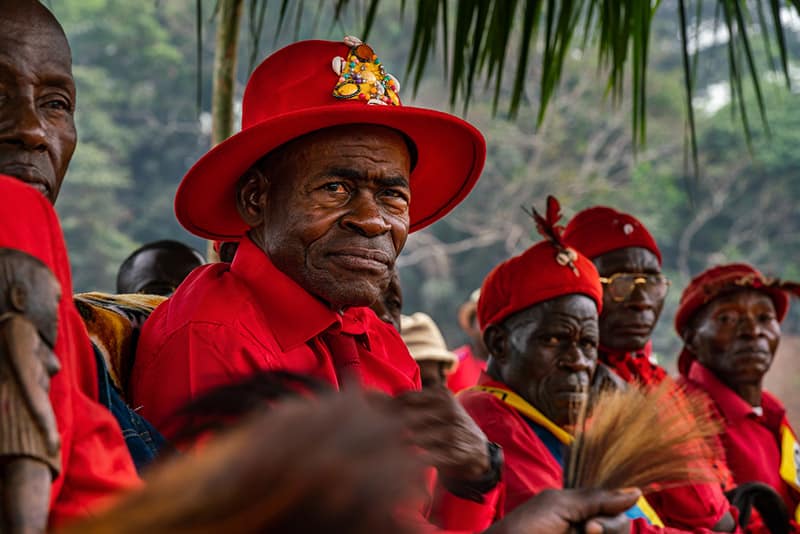
The diplomacy of traditional chiefs was invaluable for reconciling local communities and rangers in the national parks. Image © Chris Scarffe
Bringing in diverse perspectives
That’s really interesting. However, your work with the Conference of the Central African moist forest ecosystems and the partner organisations in our Congo Basin Programme has not just focussed on the chiefs, but others in the community who don’t have as much influence, and even those whose needs have been historically marginalised, such as women and Indigenous Peoples. At what point in your career did their voices start to be successfully included in conservation decision-making?
Bihini: All this started in 1996, when the realisation came that during discussion forums concerning forest, there were less voices from Indigenous Peoples, there were less voices from civil society, and also less voices from the private sector.
At that time, I was a programme officer, and we started thinking about how to bring all those constituencies together and have a discussion. The first session was on tropical moist forest in May 1996, and from the conference came the idea of creating networks of specific constituencies, like women, like Indigenous Peoples, like youth, and many of these networks are still alive today.
What kind of issues did these constituencies bring to the table which had maybe not been discussed before?
Bihini: In that first conference, women were talking about specific laws taken by governments which had not considered their views, which led to requesting the use of certain resources from protected areas that would not have been discussed without women in the room.
This was the first time we saw ministers sitting with parliamentarians and other partners, such as NGOs and the private sector, to discuss important forest resource management issues before decisions were made that would impact people in the community.
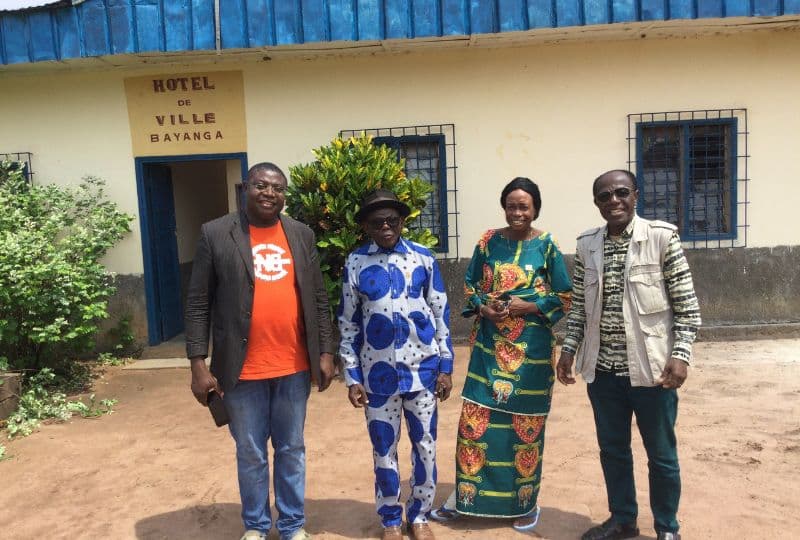
Bihini meeting with the mayor of the city of Bayanga in Central African Republic as part of the Regional Programme of Support for the Conservation of the Congo Basin Ecosystems. Image: Bihini Won wa Musiti Jean
Hope for the future
There have been some huge changes in conservation over your career. What gives you hope for how much is possible when these groups can be heard and work together?
Recently, the Senate approved the law to promote and protect the rights of Indigenous Peoples in the Democratic Republic of Congo and the President of the Republic promulgated it. It will undoubtedly bring about a huge change for the Pygmy community.
It has been a long process, led by Dynamique des Groupes des Peuples Autochtones (DGPA), but it was for a huge transformation, and I’m really happy to have been part of the support from Synchronicity Earth for Indigenous Peoples which has led to this result, this very successful story of the century.
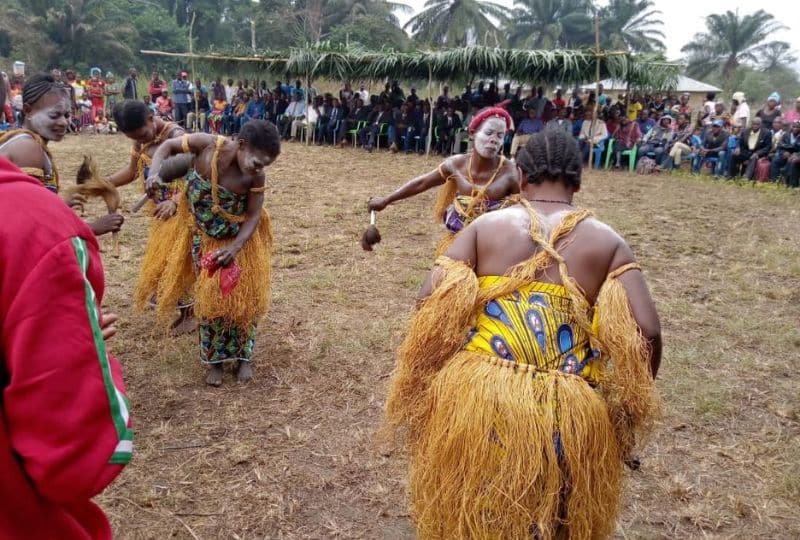
Mbou Mon Tour hold events to communicate the importance of bonobo conservation to local communities. Image © Mbou Mon Tour
It is such a huge success, and a huge credit to DGPA. What other successes have you seen made by the Congo Basin programme partners?
Bihini: There are so many! Let me start with Mbou Mon Tour (MMT). MMT works to protect the bonobos, and when I think about how they have grown over the last four years, it has been a huge change. Their approach is to support the community protecting the bonobos with their needs, so they built a maternity centre for women to give birth safely- that was what the community asked for. Now they have strong roots in the community, it is much easier for them to talk to people about the work they are doing with the bonobos.
I’m also thinking about the women’s networks which have now been around for long enough that they are getting really mature, such as Solidarity of Women of the Congo River (SOFFLECO in French). They have been growing and learning, and now they are at the stage when they can think about the next three, four, or five years, and the changes they would like to see, reflecting on what they have learned from their experiences so far and letting that influence their decisions about the future.
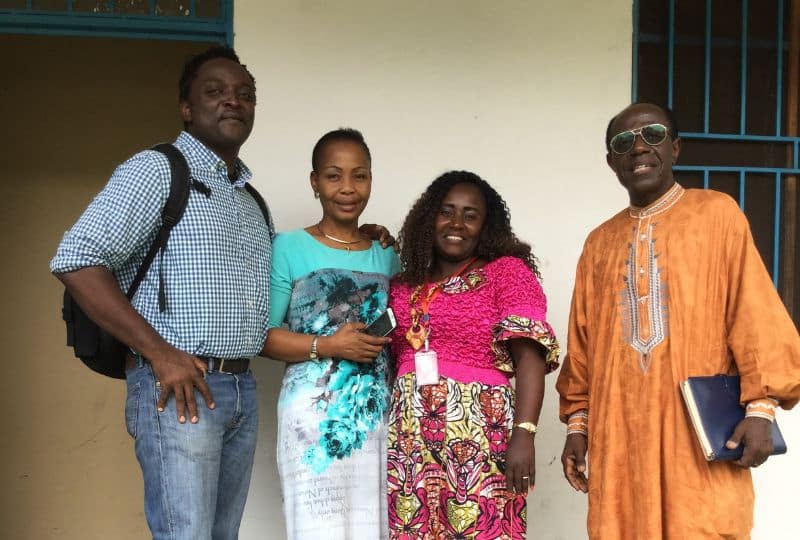
Bihini visiting Femmes Solidaires (FESO) in the Democratic Republic of Congo with Doudou Kalala from Well Grounded (left), pictured here Blandine Bonianga (centre left) and Mignonne Mbombo (centre right) of FESO. Image: Bihini Won wa Musiti Jean
Challenges to overcome
Looking forward, what are the biggest challenges facing conservation in the Congo Basin?
Bihini: One of the biggest challenges is demography. As the population is increasing, we have to take into account how the development of infrastructure will affect people on the ground. We need solutions for food, not just relying on collecting food from forests, but the production industry has to take into account the growing population if we want to sustain our ecosystems.
Another issue is mining. There are many areas in Central Africa where you will find mines that were very exploitative projects that did not consider the impact on the ecosystem. Many times, these changes are not an issue at the time, but later on it becomes an issue for local people, so we have to think about the impact much earlier on, before it is too late.
Then the other aspect is what I call the improvement of life. The improvement of livelihoods is very important because if it is not, the huge efforts in conservation could all be lost because people won’t understand that the work of conservation is not only for nature, but also for them. If they can find solutions to live their lives sustainably with nature, we can keep these natural resources.
The relationship between conservation and development is a huge problem which has been here decade to decade and cannot be ignored. So, conservation must be linked with development. How is it seen? How is it discussed? What are the solutions? We cannot say no, we need to stop development, we have to learn how to look at the situation and make the development solutions as sustainable as possible.
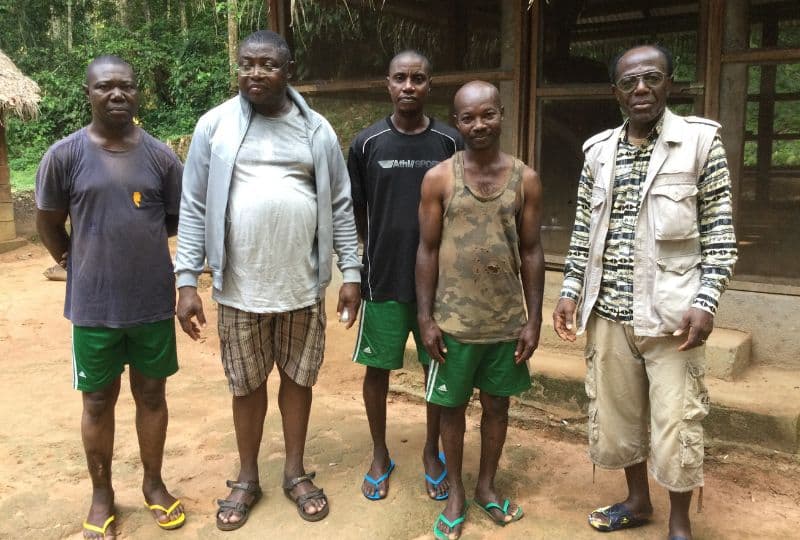
Bihini visiting local stakeholders in the Sangha Trinational (TNS) landscape in the Central African Republic, next to the protected areas of Dzanga-Sangha. Image: Bihini Won wa Musiti Jean
The relationship between development and conservation is a difficult one, especially as historically they have generally been pitted against each other. What do you think the opportunities are going forward?
Bihini: To use the example of DRC, a key solution here is community forest management. For now, the government is allowing people to have space for managing their land, and even though it is seen as forest management, it has genes of preservation, conservation, and development. There are many solutions here, because the steps of community forest management deal with deforestation, sustainable livelihoods, building infrastructure, and there are laws and agreements that can be made, such as the historic law which just passed in the Senate. I think this will be really key to reinforce the mechanism of community forest management for Indigenous Peoples, and that we will see it being used for the next decade by communities to solve many of these problems.
Thank you for that dose of optimism! Do you have any final reflections?
Bihini: The model of how Synchronicity Earth works with partners is not yet used by many other organisations, so my role with Synchronicity Earth as an affiliate is quite unique. I think this means we have an opportunity to take lessons from what we are doing, and some of those lessons we have been discussing today. I’m looking forward to seeing how we can continue to learn, what we are learning, and how we can go back to the ground and share mutual lessons with those who are acting directly with people and wildlife.

